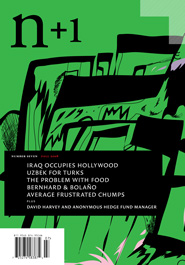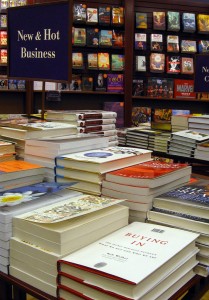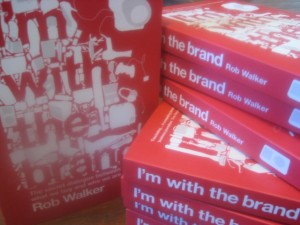So it’s the end of the year. Time for a quick wrapup and an announcement or two.
Also there’s a survey, and to get people to participate, I’ll be giving away a still-in-the-shrinkwrap Blu-ray DVD of the acclaimed documentary Helvetica. (This was given to me, but I own a regular DVD version already and do not have a Blu-ray machine.)
1. Consumed: In 2009, I’ll be writing Consumed three out of every four weeks, as opposed to every week. I’ve now been writing the column for five years, and asked for a reduced schedule because I would like to free up time to write more feature stories, among other things. Am I nervous about reducing the frequency of my steadiest cashflow source? Very much so. But sometimes fear is a good motivator.
2. Back in February I announced — or admitted — that I’d started a Facebook page for Consumed. Recently the page passed the 500-fan mark. That’s nice. Thanks to those of you who fanned up in 2008.
3. I’ve been giving a lot of thought to the future of this site. I’ve considered everything from expanding it by including contributions from others, to shutting it down altogether. I have drawn no conclusions, but everything is still on the table.
Which brings me to:
The Murketing Survey: It’s only a few questions, pretty straightforward stuff. You can answer anonymously, but obviously if you want to win the Helvetica DVD you’d have to tell me where to send it, which would likely entail revealing your name. Totally up to you. Click Here to take survey. [Survey closed — thanks, participants!]
Thanks…
And happy new year…
I noted earlier in the sidebar the obituary of Abbott Combes. He was known to colleagues as Kit, and he was in fact my colleague: an editor at the Times Magazine who worked on the copy desk while I was on staff as a story editor, and in the building, back in the late 1990s. Every so often we’d have lunch in Bryant Park. I liked him quite a bit, and had tremendous professional respect for him. A very smart guy, and, truly, an original. I suppose he could be a little sharp with people sometimes, but that’s because he had standards, and an agile mind. So when Kit said he liked something I wrote, it meant a lot — because he didn’t say it often, and he certinaly never said it without meaning it.
He also didn’t write often, but when he did, his stuff was very good: His writer’s voice was smooth and unpredictable at the same time, and that’s not easy.
Here is a short essay he wrote about his necktie habit, written back in 1999. What you’ll find in reading it, I believe, is a skill at suggesting a lot of life and wisdom between the lines. This can only be done subtly — without overpowering the easygoing and very accessible subject at hand. A hard thing to do is draw attention to the writing, and not to the writer. Here, it gets done.
Here is another essay, from a few years earlier, about another sartorial habit. This time I’ll quote: “I am the 50-something guy you may have seen in summertime Manhattan going about his business clad in coat and tie, dressy loafers (no socks) and what used to be called Bermuda shorts. I didn’t set out to become an ensign of men’s style, but one I seem to have become, recognized uptown and down by my . . . knees.” This is no joke. When I picture Kit, I picture him in his Memorial Day-to-Labor Day iteration: The shorts and the loafers and the jacket, and looking like a million bucks. I have known a lot of people who supposedly have style. I will say nothing negative about them, but I will say: Friends, this guy had style.
One more, and I’ll stop: A short essay called “Family Portrait,” from 2006. I won’t attempt to sum it up, but I remember when I read it the first time being mightily impressed at the economy of the piece, at (again) his skill in communicating by omission, always keeping an easy and readable tone. I will also say — and I think he would almost expect me to — that having been on the writer/editor side of Kit’s strict copy desk persona, I have a feeling I’d have had to argue pretty hard to get away with something like that “Sobeit” he slips in at one point.
Then again, I’ve always believed that when it comes to writing, to the use of language, you earn your way to breaking rules. And he earned it. So be it.
More of his writing is here.
I don’t get to the Times much these days, and so it’s been a while since I chatted with Kit face to face, or even by phone. But I feel a loss at the idea of him not there … in the shorts and the loafers … calling me out on some bit of linguistic bullshit or other. Wherever you may be, sir, you are missed.
Posted Under:
Obituaries
This post was written by Rob Walker on December 30, 2008
Comments Off on Kit
 A story in the WSJ yesterday explained that Unilever’s famous “Campaign For Real Beauty” for its Dove products wasn’t working in China, where “women aren’t so bothered by the stunning models used in most beauty ads and aren’t driven to buy products promoted with so-called real faces.” Apparently the multinational has found what it hopes is a solution, by way of “Ugly Betty.” No, they aren’t simply sponsoring the Chinese version of the show — they’ve worked out a deal to basically produce a Chinese version of the show:
A story in the WSJ yesterday explained that Unilever’s famous “Campaign For Real Beauty” for its Dove products wasn’t working in China, where “women aren’t so bothered by the stunning models used in most beauty ads and aren’t driven to buy products promoted with so-called real faces.” Apparently the multinational has found what it hopes is a solution, by way of “Ugly Betty.” No, they aren’t simply sponsoring the Chinese version of the show — they’ve worked out a deal to basically produce a Chinese version of the show:
In an unusual move, Unilever’s ad-time-buying agency, WPP Group PLC’s Mindshare, brokered a deal to bring the format to Chinese TV, giving Unilever the right to exclusive ads and product placements during the show, as well as a script built around the company’s Chinese reformulation of the campaign for real beauty. …
On “Ugly Wudi,” protagonist Lin Wudi, who works at an ad agency, learns to unveil her own beauty, using Dove products and working on an imaginary ad campaign for the brand. …
In one episode, an actor playing the media director for Dove in China explains that an ad campaign that Wudi helped create epitomizes Dove’s view on beauty. “There are so many kinds of women and so many kinds of beauty,” he says. “This is exactly the message that Dove tries to put forth.”

I’m late to the party on this, as I am on so many things, but:
While I’d obviously been hearing about n+1 for a while, none of what I’d heard interested me enough to track down a copy until recently. And even when I bought the current issue, it was only to read a piece by Jace Clayton/DJ Rupture about the international DJ scene. That was quite good and interesting, and would have been enough for me. But I must say that pretty much the entire magazine has turned out to be an outstanding read.
There’s a series of Q&As at the beginning with an anonymous hedge fund manager that’s completely fascinating and illuminating regarding the current financial situation; Benjamin Kunkel has a good essay on a framework for thinking about internet expression that I’m still pondering; one of the editors wrote an well-thought-out article on food; and, in particular, there’s an essay about Iraq war films by A.S. Hamrah that I found outstanding. There are a number of reasons for this, but the main thing that struck me was just what a great and pleasurable piece of writing it was. It reminded me of the distinction between, say, what I do for a living, and the real thing. Dare I say I found it inspiring?
In any case, I’m motivated to say nice things on this site more often.
So I say: n+1 seems like a great publication. Check it out, if you haven’t already.
Listening to a Science Friday segment about New Year’s resolutions, I was struck by the answer to a caller who wanted to know what guest John Norcross thought about the difference between inspiration and motivation. (In this context, being inspired to make/keep a resolution, and being motivated to do so.) I was so struck I went back to hear Norcross’s answer again. Here it is:
Inspiration is short-lived. It’s typically emulating other people, and it’ll push us for a week or two. But inspiration begins to extinguish quite quickly. And as Henry Ford once said, after that it’s 90 percent hard work. Inspiration may get us started, but it never keeps us going. And that’s where (accutane) motivation works.
And motivation doesn’t come in a bottle. Motivation is, scientifically speaking, a series of small behaviors.
He goes on to talk about how motivation entails tracking progress of the behavior change in question, rewarding yourself as you hit milestones, and the like. I don’t know if he’s relying on research when makes these distinctions, or not.
Anyway the reason this struck me is that I think there’s an awful lot of emphasis on “inspiration” in the marketing/design world of ideas. When I hear talks (more often via some online venue than in person) from this or that guru (and this includes people who call themselves “motivational” speakers, actually), their point always seems to be to inspire the audience. People are always asking me about inspiration, and conferences seem to revolve around inspiration, and basically inspiration seems to be a venerated zithromax concept.
Similarly, people are inspired by Obama’s call for change, but are they (we) motivated to follow through and do something real, something difficult? Inspiration is enough to submit your idea to Change.gov, but it’s probably not enough to actually change anything. People with ideas are a dime a dozen; people who execute are rare. I don’t know about you, but when I look at my to-do list, I wonder where I fall on that continuum — will I be motivated to get things done this year, or merely inspired to add to add to my list?
Anyway, I guess I wonder if all the inspiration offered by gurus is a bit of a disservice. It’s like a jolt of caffeine; it won’t last. (It’s another variation of the instant-ness problem I wrote about the other day, maybe.) You’ll feel briefly like you’re on a new path, but it fades. You get pumped up and “inspired,” and then before long you’re right back where you were … needing “inspiration” again.
That’s good news for the guru industry. It may not be good https://www.drsunilthanvi.com/diflucan-fluconazole-order/ for anybody else.
 ENTERPRISING:
ENTERPRISING:
Her Star Trek conventions harnessed the power of media fandom long before the barons of content did.
The New York Times Magazine publishes its annual The Lives They Lived issue this weekend, and Consumed focuses on the Star Trek fan who helped organize the first Trek convention.
There’s another way of looking at such fans: as extremely active media consumers. And there’s another way of looking at the Trek convention culture Winston helped create: as like-minded individuals gathering to connect over a shared taste. In other words, Winston’s world was a template for what is now widely seen as the mainstream-media-consumer paradigm of the 21st century. Henry Jenkins, co-director of the M.I.T. Comparative Media Studies Program, has been studying and writing about media fans for more than 20 years and has summarized the Facebook/YouTube era as fandom without the stigma. “It takes all the things that fans have been doing throughout the 20th century and makes them public, mainstream, commercial,” he told me in an interview. “The mechanisms that fans were early pioneers of have become absolutely widespread in our society, whether we’re talking about early communities or social networks or participatory culture.”
Read the column in the December 28, 2008, issue of The New York Times Magazine, or here.
Consumed archive is here, and FAQ is here. Consumed Facebook page is here.
“Letters should be addressed to Letters to the Editor, Magazine, The New York Times, 620 Eighth Avenue, 6th Floor, New York, N.Y. 10018. The e-mail address is magazine@nytimes.com. All letters should include the writer’s name, address and daytime telephone number. We are unable to acknowledge or return unpublished letters. Letters may be edited for length and clarity.”
Posted Under:
Consumed,
Entertainment,
Fandom
This post was written by Rob Walker on December 27, 2008
Comments Off on In The New York Times Magazine: Joan Winston
The caption is: “Break Time MFA gas station in Columbia in Boone County Missouri. Please check out my photos at:
notleyhawkins.imagekind.com/. ©Notley Hawkins.”
I don’t have an iPhone, and have no plans to acquire one. But I have to admit I’m becoming increasingly intrigued by some of the applications I read/hear about.
Here are two that seem to take, or aim to take, one of the most familiar notions of the American urge to acquire to new levels. The notion I refer to is: instant-ness.
Instant-ness example number one: Looking at an iPhone ad on the back page of a newspaper (I know it’s verboten to mention actually noticing an ad in the newspaper, but set that aside), I zeroed in on an app called Shazam. “Ever hear a song wonder who sings it? Just hold your iPhone up to the music and, in seconds, you have the name, artist and album, plus a link to iTunes so you can get it for yourself.”
Instant-ness example number two: A friend of Consumed dropped me a line the other day about the iPhone’s Amazon app. “You are supposed to photograph something and then Amazon searches for it… ( face recognition tech??),” he wrote. “I suppose leading to a time when you would see someone’s watch, snap a photo with your phone and have it delivered overnight? Or use Genius to find the range of similar things you would like? Shopping synapse.”
While I don’t know enugh about the app to know if that first part is an accurate description, I’m guessing the general direction in which the technlogy will move is much as my correspondent suggests.
Everybody loves instant-ness, I guess. But I would also suggest that the instant is the enemy of the special. Making an effort to track something down (a song name, a model of watch) has its own rewards. I think the process adds to the eventual value and meaning of the thing — at least in those cases when you stick with it, shaking off or forgetting those instances where the effort isn’t worth it, a winnowing process that is also its own reward.
But clearly the future seems to be: You hear it, you see it — you own it. And then what? You lose interest in it, that’s what. And you move on to the next new novelty that crosses your path. The pleasure of the new novelty from a few days, hours, minutes ago — well, that’s forgotten.
In an instant.

Chapters, Waterloo, ON December 2008
So in the course of putting together that earlier post about crafty stuff, I was trying to remember if Ad Age‘s uniquely dismissive assessment of Buying In (“not worth the time”) had made any mention of the book’s chapter on Etsy and the Austin Craft Mafia and the handmade phenomenon. I’d correctly remembered that it did not.
But here’s something far more interesting: I was surprised to discover that at some point in the past six months Ad Age has added a “A Second Opinion” about the book, written by a different reviewer.
Mya Frazier (I know the byline, but not the person) has a different view — “a worthwhile read,” “a valuable whirlwind tour of how consumers’ hunger for inclusion plays out in some of today’s most penetrative brands,” etc. — and I’m pleased to say picks up in particular on the chapter that was in fact most specifically written with marketing pros in mind. (Chapter 12, on consumer and murketing ethics in the marketplace; many marketers will still not care for it — not enough “takeaways” — but that’s life.)
I can’t recall ever seeing a publication offer “A Second Opinion” about a book it trashed. I looked at a few other entries on Ad Age‘s book page and didn’t see any other instances. A very unusual thing, seems to me. I wonder how it came about.
Anyway, on that note of curiosity, it’s just about time for the Murketing Organization to shut down. Enjoy your holidays.
[Re that pic: Thanks Mr. Harwood!]
One other quick update:
Lest you ever doubt the power of Consumed, please note that after I wrote about Billy Mays in the October 24, 2008 installment of the column, the creator of BillyMaysRules.com not only got an autographed picture of Mays — but a rare Mays bobblehead doll! (More here.) How about that?
I meant to mention this earlier, but was just reminded of Mays by AdFreak, which reports that ESPN360.com is using Mays in some ads: “They’re almost parodies of parodies, so unrelentingly stupid that they’re amazingly effective.”
Posted Under:
Update
This post was written by Rob Walker on December 24, 2008
Comments (0)
Surely if you have the slightest interest in handmade/DIY/craft culture, you saw the NYT’s big story about how the category is faring in the downturn:
Craft stores, from giant chains like Michaels Stores to small scrapbook supply shops, are reporting that sales are higher compared with the last holiday season, and online marketplaces for handmade goods, like Etsy, are seeing a boom in listings and transactions.
Handmade/craft was also the theme on KCRW’s Design And Architecture this past weekend. (In an amusing moment, host Frances Anderton alluded to the same theme as that Times article while interviewing the creative director of Heath Ceramics: There’s all this unemployment and other bad economic news, Anderton obesrved, “And yet this store is a massive vote of confidence, it seems, in people’s ability to keep on buying nice ceramics.”)
Earlier Murketing noted that Etsy’s sales have been resilient. And I don’t think this broad story is going to go away anytime soon. I of course have a chapter on the crafty scene in Buying In, covering Etsy to some extent as well the Austin Craft Mafia and others.
Although I just poked fun at Anderton’s bit about “the ability to keep on buying nice ceramics,” the person from Heath actually had a response that is pretty much on point regarding the bigger question of why this segment may be holding up better than others: Some consumers still want special things, things with a narrative to them; and the handmade world feels distinct from the big-corporate world that some consumers have lost trust in.
There are different ways to assess the alternative vision of material culture that the handmade scene may or may not be offering us — but I don’t want to rehash the book here. Suffice it to say the questions are compelling enough, I believe, that they’ll stick with us in the year ahead, and more and more people are going to be interested in those questions, and their potential answers. I noticed recently that even Advertising Age is paying attention, having rounded up Etsy founder Robert Kalin as a speaker at its Idea Conference. In all, the subject seems to have made its way onto the mainstream radar in a new way in 2008. And next year the Handmade Nation documentary will come out and will likely bring even more attention to the scene.
It should be interesting to watch.
[If you simply refuse to read Buying In, here’s the Handmade 2.0 article I wrote for the Times Magazine; here’s a series of Q&As I did with three of the Austin Craft Mafia’s founders when the book came out; here’s a link to explore all the DIYism posts on this site; and here’s a link to all my DIYism-related Delicious links.]
… what this site would look like with a huge piece of bacon on top?
Click here, and now you know.
The invaluable tool that makes this possible is here.
To get back to the bacon-free version of Murketing.com, just click your browser’s back button, of course.
Thx: E.

The UK version of Buying In was published a few months ago. There will also be translated editions (so far) in Italy, China, South Korea, Turkey, and, I think, maybe Croatia. But the UK version has a different title: It’s called I’m With The Brand there.
The publisher is Constable, and right around the time the book came out over there, they sent me ten copies. I put these in a back room and basically forgot about them. But one of the 48-Hour T-shirt designers mentioned getting an order from England, which reminded me that I guess some people who read this site are, in fact, in the UK.
So I’ve dusted off those books and I’m going to give them away.
I probably don’t have 10 UK readers, and even if I did, I’m not sure I’d want to deal with that many individual mailings. So I’m keeping two copies for my future Presidential Library, and giving away the others, in two batches of four.
So: Are you in the UK? Would you like four copies of I’m With The Brand? One to keep and three to share (or if you’ve already bought it, four to share?)
Here’s all you have to do: Write to me with your mailing address, and promise me that:
a) you won’t sell off the extra copies on Amazon or whatever but will instead give them to your friends (all of whom, I’m assuming, are influential and attractive); and
b) that you’ll eventually send me an email telling me what you’ve done with the books. It doesn’t have to be super-specific, I don’t need names and addresses, I just want to the warm feeling of assurance that you’ve done something productive with them and they’re not collecting dust.
You’re also of course invited to send photographic evidence of your appealing pals reading the book in prominent public places, or even on television. But that’s not strictly required.
So if you’re in the UK, and you’re interested, write me [redacted]. I’ll mail them some time after Xmas.
[ OFFER EXPIRED! COPIES SPOKEN FOR! SORRY!]




 "
"



 ENTERPRISING:
ENTERPRISING:















 Kim Fellner's book
Kim Fellner's book  A
A